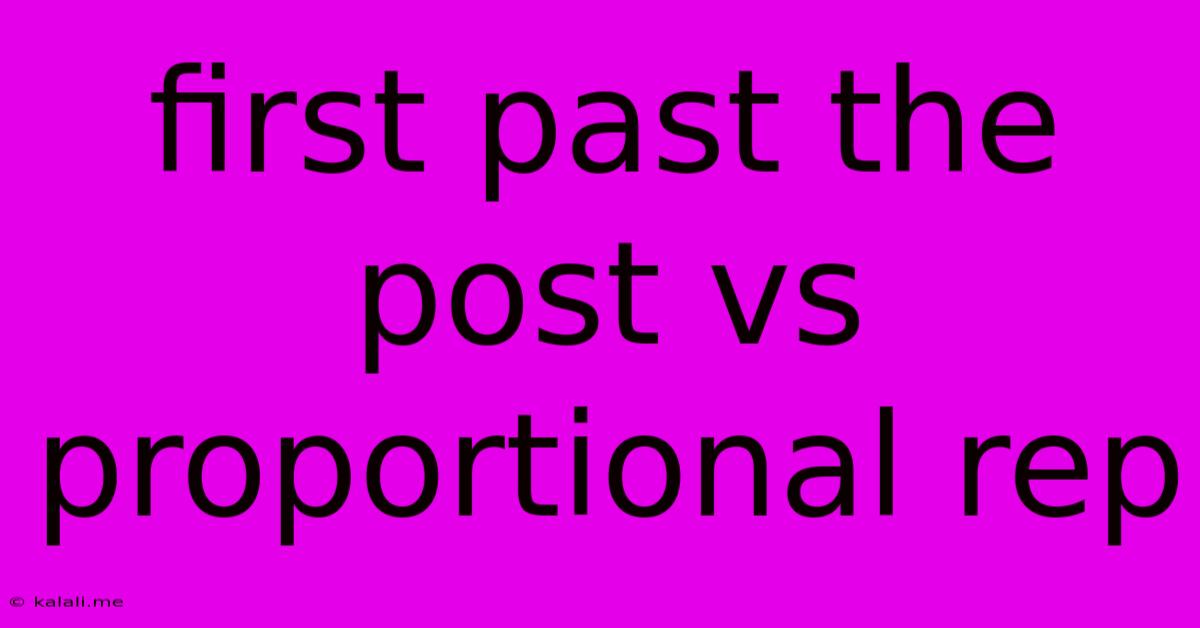First Past The Post Vs Proportional Rep
Kalali
Jun 11, 2025 · 3 min read

Table of Contents
First Past the Post vs. Proportional Representation: A Head-to-Head Comparison
Choosing the right electoral system is crucial for a healthy democracy. It directly impacts how effectively a government represents its citizens. Two dominant systems stand out: First Past the Post (FPTP) and Proportional Representation (PR). This article will delve into the strengths and weaknesses of each, exploring their impact on political landscapes worldwide. Understanding these differences is key to appreciating how different nations shape their governance.
First Past the Post (FPTP): A Simple System with Complex Consequences
FPTP, also known as "winner-takes-all," is a remarkably straightforward system. Candidates compete within geographically defined constituencies. The candidate who secures the most votes in each constituency wins the seat, regardless of whether they achieve an outright majority. This simplicity contributes to its popularity, making it easy for voters to understand.
Advantages of FPTP:
- Simplicity and Clarity: The system is easy to understand and administer, leading to fewer disputes about election results.
- Strong Government: FPTP often results in a single-party government with a clear mandate, enabling efficient policymaking and strong leadership.
- Local Representation: Constituency-based elections provide a direct link between voters and their elected representatives, fostering accountability.
Disadvantages of FPTP:
- Wasted Votes: A significant portion of votes cast may be for losing candidates, effectively nullifying their impact. This leads to disproportionate representation and can disenfranchise voters.
- Tactical Voting: Voters might feel compelled to vote strategically for a candidate with a better chance of winning, rather than their preferred candidate.
- Exaggerated Majorities: The winning party often secures a larger share of seats than their percentage of the overall vote suggests, potentially leading to an inaccurate reflection of public opinion.
- Underrepresentation of Minor Parties: Smaller parties find it difficult to gain parliamentary seats, potentially silencing the voices of significant portions of the electorate. This can lead to a two-party system dominating the political landscape.
Proportional Representation (PR): Fairer Representation, but with Trade-offs
Proportional Representation aims to allocate seats in proportion to the votes received by each party. Several variations of PR exist, including party-list PR, mixed-member proportional, and single transferable vote. The core principle, however, remains the same: ensuring a more accurate reflection of the electorate's preferences.
Advantages of PR:
- Fairer Representation: PR systems provide more accurate representation of the electorate's preferences, giving smaller parties a fairer chance.
- Reduced Wasted Votes: Fewer votes are wasted, increasing voter satisfaction and promoting inclusivity.
- Coalition Governments: PR often leads to coalition governments, forcing parties to compromise and build consensus, potentially leading to more comprehensive policies.
- Increased Voter Turnout: Some studies suggest that PR can lead to increased voter turnout due to greater feelings of being represented.
Disadvantages of PR:
- Complexity: PR systems can be more complex to understand and administer than FPTP.
- Coalition Instability: Coalition governments can be unstable, prone to internal conflicts and early collapses.
- Power to Smaller Parties: Small parties can wield disproportionate influence in coalition governments, potentially hindering effective governance.
- Weakened Party Discipline: The need for coalition building can lead to weaker party discipline and less decisive policymaking.
Conclusion: No Perfect System
Both FPTP and PR have distinct advantages and disadvantages. The "best" system depends heavily on a nation's specific political culture, history, and societal preferences. FPTP offers simplicity and strong government but can be unfair to smaller parties and lead to wasted votes. PR provides fairer representation but can lead to complex coalition governments and potential instability. Understanding these nuances is key to evaluating the effectiveness of electoral systems and their impact on democratic governance. The choice ultimately reflects a nation's priorities in balancing efficient governance with equitable representation.
Latest Posts
Latest Posts
-
World Map With Countries And Capitals Pdf
Jun 12, 2025
-
Trade Off Vs Opportunity Cost Examples
Jun 12, 2025
-
Which One Of The Following Is Not True For Minerals
Jun 12, 2025
-
Which Of The Following Is A Base
Jun 12, 2025
-
Coefficient Of Thermal Expansion For Concrete
Jun 12, 2025
Related Post
Thank you for visiting our website which covers about First Past The Post Vs Proportional Rep . We hope the information provided has been useful to you. Feel free to contact us if you have any questions or need further assistance. See you next time and don't miss to bookmark.